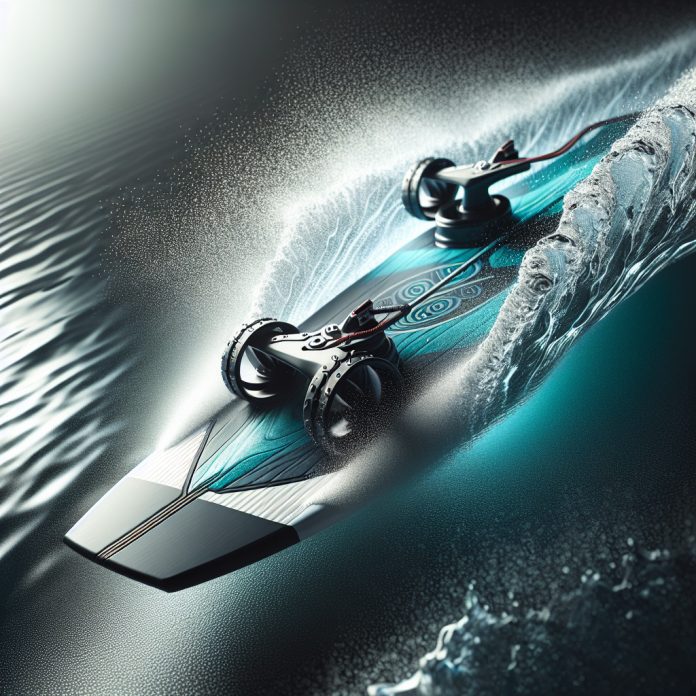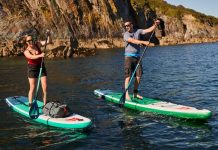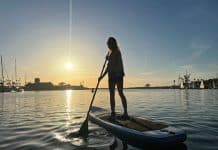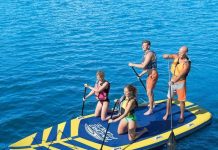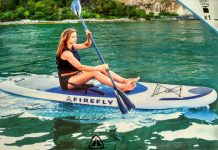In this exhilarating article, we take you on a thrilling journey into the world of wakeskating – the adrenaline-pumping sport that combines skateboarding and water skiing. Prepare to be amazed as we delve into the heart-pounding maneuvers performed by these daredevil athletes as they effortlessly glide and perform tricks on the water. Join us as we explore the incredible skill, technique, and sheer excitement that comes with wakeskating on the waves. Get ready to be captivated by the artistry of this unique water sport.
What is Wakeskating?
Wakeskating is a thrilling water sport that combines elements of skateboarding and wakeboarding. Unlike wakeboarding, which involves being strapped into bindings, wakeskaters use a skateboard-like board without bindings. Instead, wakeskaters rely on their balance and control to maneuver on the water’s surface. It requires skill, precision, and a love for the water.
History of Wakeskating
Origins of Wakeskating
The origins of wakeskating can be traced back to the 1990s when a few innovative wakeboarders started experimenting with riding without bindings. They removed the bindings from their wakeboards and rode with their feet positioned directly on the board, just like on a skateboard. This unique style of riding led to the birth of wakeskating.
Evolution of Wakeskating
As wakeskating gained popularity, manufacturers began to develop specific boards and accessories tailored to the sport. The boards became more durable and specialized, designed to withstand the rigors of being ridden on the water’s surface. Wakeskaters also started to develop new tricks and techniques, pushing the boundaries of what was possible on a wakeskate board.
Equipment Required for Wakeskating
Wakeskate Board
The wakeskate board is the most crucial piece of equipment for wakeskating. It is similar in shape to a skateboard, but with added features to handle the unique challenges of being ridden on water. Wakeskate boards are usually made of wood or composite materials and come in various sizes and designs to suit different riding styles and skill levels.
Bindings
Unlike wakeboarding, wakeskating does not require bindings. Riders rely solely on their balance and foot placement to stay on the board. However, some wakeskaters may choose to use grip tape or traction pads for added stability and control.
Life Jacket
Safety should always be a top priority when engaging in any water sport. Wearing a life jacket is essential to ensure personal safety while wakeskating. It provides buoyancy and can potentially save lives in case of an accident or unexpected fall.
Helmet
To protect against head injuries, it is highly recommended to wear a helmet while wakeskating. Helmets designed specifically for water sports provide the necessary protection and ensure peace of mind while performing tricks or riding at higher speeds.
Boat or Cable System
A boat or a cable system is needed to generate the wake or wave necessary for wakeskating. Boats with wake-specific features, such as ballast tanks and tower-mounted tow ropes, are commonly used. Cable systems consist of an overhead cable system with carriers that pull the wakeskater along a predetermined path, eliminating the need for a boat.
Different Types of Wakeskating Tricks
Air Tricks
Air tricks in wakeskating involve jumping off the wake or wave and performing various flips, spins, and grabs while airborne. These tricks require a combination of skill, timing, and control to execute properly.
Ledge Tricks
Ledge tricks in wakeskating involve using man-made structures, such as docks or rails, to perform various slides and grinds. Wakeskaters use the edges of these structures to slide along and perform stylish tricks and maneuvers.
Rail Tricks
Similar to ledge tricks, rail tricks in wakeskating involve using specially designed rails or sliders to perform slides and grinds. These features are often installed in wake parks or other designated wakeskating areas.
Flatland Tricks
Flatland tricks in wakeskating are performed on calm water areas without the aid of a wake or wave. Wakeskaters use their creativity and skill to perform various flips, spins, and technical maneuvers on the water’s surface.
How to Get Started with Wakeskating
Find a Wakeskate Spot
The first step in getting started with wakeskating is to find a suitable spot. Look for lakes, rivers, or wake parks in your area that allow wakeskating. Make sure the location is safe, has suitable water conditions, and is accessible for boats or cable systems.
Learn the Basics of Wakeskating
Before attempting any advanced tricks, it is essential to learn the basics of wakeskating. Begin by practicing balancing on the board, getting a feel for the water, and learning to control the board’s direction. Start with small waves or wakes and gradually work your way up to more challenging conditions.
Get Proper Instruction
To progress safely and efficiently, consider enrolling in wakeskating lessons or getting instruction from an experienced wakeskater. A skilled instructor can provide guidance, teach proper techniques, and help you overcome any challenges you may encounter.
Practice and Progress
Like any sport, consistent practice is key to improving your wakeskating skills. Set aside regular practice sessions and focus on mastering one trick at a time. Stay patient, be persistent, and don’t be discouraged by falls or setbacks. With time and dedication, you will see progress and achieve your wakeskating goals.
Wakeskating vs. Wakeboarding
Similarities and Differences
While wakeskating and wakeboarding both involve riding on the water’s surface and are popular water sports, there are significant differences between the two. Wakeboarding involves being strapped into bindings, while wakeskating utilizes a skateboard-like board without bindings. Wakeskating requires a higher level of balance and control since riders rely solely on their feet for stability. Wakeboarding, on the other hand, provides more stability and support through the bindings, making it easier for beginners to learn.
Which One is Right for You
Deciding whether to pursue wakeskating or wakeboarding ultimately comes down to personal preference and skill level. If you prefer a more challenging and unrestricted riding style, wakeskating may be the right choice for you. However, if you value stability and ease of learning, wakeboarding may be a better fit. Trying both sports and seeking advice from experienced riders can help you make an informed decision.
Benefits of Wakeskating
Full Body Workout
Wakeskating offers a full-body workout that engages muscles throughout the entire body. Balancing on the board, performing tricks, and maneuvering through the water requires strength, endurance, and coordination. Regular wakeskating sessions can help improve muscle tone, cardiovascular fitness, and overall physical health.
Improves Balance and Coordination
The constant need to maintain balance and control on the wakeskate board greatly enhances balance and coordination skills. Wakeskating challenges the body to adapt and respond to the ever-changing conditions of the water, leading to improved proprioception and body awareness.
Enhances Mental Focus
Wakeskating demands intense concentration and focus to execute tricks and navigate the water’s surface effectively. By honing mental focus, wakeskating can help improve cognitive skills such as decision-making, problem-solving, and reaction time.
Improves Water Sports Skills
Wakeskating can have a positive impact on other water sports skills. The core strength and balance developed through wakeskating can translate to improved performance in activities such as wakeboarding, surfing, and paddleboarding. Wakeskating also cultivates an understanding of water dynamics and helps to develop a solid foundation for other water-based activities.
Popularity and Community of Wakeskating
Growth of Wakeskating
Since its inception, wakeskating has experienced steady growth in popularity. More wake parks and dedicated wakeskating areas have been created, allowing enthusiasts to enjoy the sport in a controlled and safe environment. Wakeskating is gradually gaining recognition as a legitimate water sport, attracting more participants and spectators alike.
Competitions and Events
Wakeskating competitions and events provide a platform for skilled wakeskaters to showcase their talent and push the boundaries of the sport. These events feature various categories, from amateur to professional, and include disciplines such as obstacle course runs and trick competitions. Participating in or attending wakeskating competitions can be an exciting way to immerse oneself in the vibrant wakeskating community.
Online Communities and Resources
The digital age has allowed wakeskaters from around the world to connect and share their love for the sport through online communities and resources. Websites, forums, and social media platforms provide a space for wakeskaters to exchange tips, tricks, and experiences. Online tutorials, videos, and equipment reviews are valuable resources for beginners and seasoned wakeskaters alike.
Famous Wakeskaters in the Sport
Reed Hansen
Reed Hansen is a well-known figure in the wakeskating community and is considered one of the pioneers of the sport. With numerous wins in wakeskating competitions, including multiple X-Games gold medals, he has solidified his status as one of the best wakeskaters in the world.
Brian Grubb
Brian Grubb is another prominent wakeskater known for his creativity and innovative riding style. Grubb has been instrumental in pushing the boundaries of wakeskating by introducing unique tricks and riding environments. His achievements and contributions to the sport have earned him a place among the wakeskating legends.
Ben Horan
Ben Horan is recognized for his technical and precise wakeskating skills. His ability to execute complex tricks with precision and style has made him one of the most respected wakeskaters in the industry. Horan’s dedication and passion for the sport have inspired many aspiring wakeskaters worldwide.
Austin Pastura
Austin Pastura is known for his smooth and fluid riding style, which emphasizes flow and creativity. His ability to seamlessly link tricks and his fearless approach to obstacles have earned him a reputation as an influential wakeskater. Pastura’s contributions to wakeskating have fueled its progression and popularity.
Safety Tips for Wakeskating
Wear Protective Gear
Safety should always be a priority when wakeskating. Wearing a life jacket and helmet is crucial to protect against potential injuries. Additionally, consider wearing protective gear such as knee and elbow pads to minimize the risk of joint injuries.
Choose Suitable Conditions
Before wakeskating, assess the water and weather conditions. Avoid wakeskating in rough or stormy weather, as it can increase the risk of accidents and make it harder to control the board. Opt for calm waters with minimal boat traffic to ensure a safe and enjoyable experience.
Know Your Limits
It is essential to know your skill level and limitations when wakeskating. Avoid attempting tricks or riding in conditions that exceed your abilities. Progress at a pace that is comfortable for you and gradually challenge yourself as you gain confidence and experience.
Be Aware of Surroundings
Always be mindful of your surroundings when wakeskating. Stay alert for other boats, obstacles, or swimmers in the area. Maintain a safe distance from any potential hazards to minimize the risk of accidents or collisions.
Wakeskating offers an exhilarating blend of skill, creativity, and water-based adventure. Whether you’re a seasoned rider or a curious beginner, the world of wakeskating welcomes you with open arms. Embrace the challenge, enjoy the water, and skate the waves with passion and respect. Happy wakeskating!

